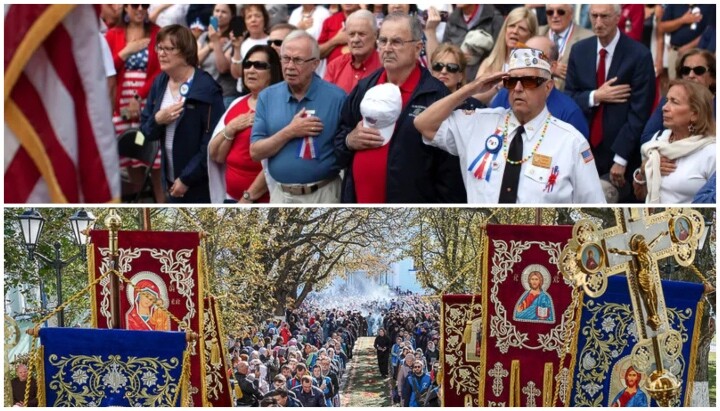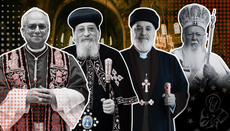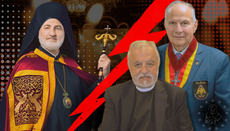Stars, Stripes, Celebrities, and Secular Veneration in America

Veneration is unavoidable – Orthodoxy provides a right-ordered practice of it.
NOTE: This is the first of a two-part series examining veneration and its practice in both Orthodoxy and secular culture.
On a recent trip to Philadelphia, a particular part of the Liberty Bell exhibit popped out to me – the description of processions and parades held with the bell in which people reached out to it, touched it, weeped over it, and even kissed it “as if it were a holy relic.”
The bell certainly had become a relic, representing the great ideal of “liberty,” and was sent across the country as “an avatar of all (the people) believed their nation to be.” One historian writes, “The Bell is the great American patriotic symbol, almost a national Palladium. About that 20-odd hundred weight of cracked metal there probably clings more of devotional feeling than about any other merely physical thing in the country.”
To this day, the Liberty Bell is deployed as an icon of American strength and unity. Although it is no longer touched, it is still visited by thousands upon thousands of people each and every day.
These people, whether they recognize it or not, are engaging in veneration. And there is nothing wrong with that. Veneration is a natural impulse, a recognition of the transcendent being encapsulated in the material. We as Americans have a number of things that are venerated and are pointed to as essential components of the national conscience.
Despite this accepted practice of patriotic veneration, the act of veneration in a religious setting is generally seen as idol worship at worst and kooky and inappropriate at best.
In a Protestant nation, which harbors some tendencies that are quite secular, this natural impulse is no longer right-ordered as it was in early Christian times, but rather runs rampant through the adoration of celebrities, and the collection of items related to them, and the overdependence on national symbols to express those transcendent ideals which find their proper place in Christ.
Americans see the bowing down and kissing of an icon or the veneration of the relics of a saint as ridiculous, offering the honor that is due to God to wood and dead people. Interestingly, things like hanging onto every word of a megachurch pastor, arguments over whose study Bible is the best, or removing your cap and placing your hand over your heart for our country's flag aren’t seen as veneration.
But in Orthodox Christianity, the practice of religious veneration never went away. In Orthodox Christianity, veneration maintains its historic and beneficial order – the holiness of the saints as a pathway to knowledge and worship of the One True God.
What is veneration, and why do we do it?
“Then Elisha died, and they buried him. And the raiding bands from Moab invaded the land in the spring of the year. So it was, as they were burying a man, that suddenly they spied a band of raiders; and they put the man in the tomb of Elisha; and when the man was let down and touched the bones of Elisha, he revived and stood on his feet.”
- 2 Kings 13:20-21
“Now a certain woman had a flow of blood for twelve years, and had suffered many things from many physicians. She had spent all that she had and was no better, but rather grew worse. When she heard about Jesus, she came behind Him in the crowd and touched his garment. For she said, ‘If only I may touch His clothes, I shall be made well.’ Immediately the fountain of her blood was dried up, and she felt in her body that she was healed of the affliction.”
- Mark 5:25-29
“And believers were increasingly added to the Lord, multitudes of both men and women, so that they brought the sick out into the streets and laid them on beds and couches, that at least the shadow of Peter passing by might fall on some of them.”
- Acts 5:14-15
“Now God worked unusual miracles by the hands of Paul, so that even handkerchiefs or aprons were brought from his body to the sick, and the diseases left them and the evil spirits went out of them.”
- Acts 19:11-12
In the short but sweet Book of Jude, there is a “blink and you miss it” reference to St. Michael the Archangel “contending with the devil” over the body of Moses.
Why Satan wanted the Prophet’s body, we do not know. Surely for something sinister, as he could have tempted the Israelites to use Moses’ body as a shrine or idol similar to the Golden Calf or the bronze serpent. In Satan’s twisted view, it could have even been a ploy to prevent Moses’ salvation, which would mean that he understands the essential role that our bodies play in our salvation.
However, this is all speculation. What we do know is that, in three of the four Gospel accounts, Moses appears on Mount Tabor with Christ at His Transfiguration, talking with Him and visibly recognizable to the apostles present. Suffice to say, whatever the devil was trying to pull didn’t work.
But the underlying message is clear – Moses’ body mattered, in both a physical and spiritual sense.
Mankind has always practiced veneration, which is simply the respect or awe inspired by the dignity, wisdom, dedication, or talent of a person, in the strict dictionary definition. Every generation has had its venerable figures – if you consider the 20th and 21st centuries, you will surely have certain individuals come to mind who are woven into the fabric of recent history with their words and actions.
As seen in the passages of Scripture above, veneration extends to more than just, “this person is good, therefore we honor them.” Holy people are venerated, not just for the honor that is due to them, but for the healing power they possess through and in Christ.
In the Old Testament, the bones of Elisha raise a man from the dead. In the Gospels, a woman is healed simply by touching Christ’s clothing. Following Christ’s ascension and the sending of the Holy Spirit at Pentecost, believers of the early Church seek healing through Peter and Paul, the foremost apostles. And not just through their person, but also through items associated with them.
In John 14, Jesus makes the following promise to His apostles:
“Most assuredly, I say to you, he who believes in Me, the works that I do he will do also; and greater works than these he will do, because I go to My Father.”
These works are greater not because they are “better” or “more salvific” than the earthly ministry of Christ. Rather, He calls them greater because, after Pentecost, God’s working through mere humans is more shocking than miracles worked by Christ in the flesh. Having ascended into the heavens and being seated at the right hand of the Father, He sends the Holy Spirit, Who proceeds from the Father, to His apostles, revealing the fishermen as most wise and through them, drawing the world into His net. In this context, these “greater works” are able to take place.
These greater works were never supposed to cease. In fact, they haven’t. It is only in more recent Christian traditions where miracles have become a theatrical formality, treated as a regular part of weekly church services, and yet saints have stopped being produced and recognized. In some traditions, miracles are even seen as too “out there.”
In older traditions, though, there is still the practice of both canonizing and venerating saints. Typically it is the veneration that comes first, as a population recognizes the holiness of someone who had been living among them.
While the Church does not change in doctrinal matters, as “Jesus Christ is the same yesterday, today, and forever” (Hebrews 13:8), she is living. And for the Church to have life, and have it more abundantly (John 10:10), she must continue to produce these greater works and the saints who point us to Christ.
If the bones of Elisha raised a man from the dead, and if people hoped for the shadow of Peter to pass over them, and if handkerchiefs used by Paul were a source of healing, then the Church must continue to produce holy people such as them. Peter and Paul – and the rest of the apostles – ordained their successors, and through this apostolic succession, the Church founded by Christ remains today.
In Holy Orthodoxy, the veneration of relics is entirely biblical. Sometimes, as a support for this practice, God reveals His saints through their bodies remaining incorrupt after their repose, or their relics exuding a sweet fragrance that isn’t earthly. Take St. John Maximovitch, who was just commemorated in the Orthodox Church on July 2, whose right hand remains incorrupt so that the faithful can receive his blessing. St. John Chrysostom’s incorrupt ear remains attached to his skull – the same ear that St. Paul was seen speaking into as St. John was writing his commentaries on the Pauline epistles roughly 300 years after they were composed.
Atheists have seen myrrh-streaming icons and had no explanation for them. Prayers have been answered after a timely visit to the relics of a saint. If “God is wondrous in His saints” (Psalm 67:36 LXX), then there is no reason for the power of healing and veneration of relics to have ceased, considering that it exists in the Scriptures.
Only in a culture where worship services have been reduced to what is better described as “praise” is veneration seen as “idol worship.” When God is only venerated with songs and a sermon, and there is no sacrifice in the Eucharist or transcendent sense of participation in the heavenly pattern of worship, it is only natural to see the veneration of saints as honor that is only due to God.
If “God is Spirit, and those who worship Him must worship in Spirit and Truth” (John 4:24), then what passes for worship today is sadly so little compared to what has been revealed and passed down to us. As Christ became incarnate and blessed the entire creation with His presence, and as the Holy Spirit permeates all things with His goodness, we, too, are called to participate in this reality.
Thus, the veneration of relics is not only reasonable, but essential. So essential, in fact, that Canon VII of the Seventh Ecumenical Council declares:
“For as they took out of the churches the presence of the venerable images, so likewise they cast aside other customs which we must now revive and maintain in accordance with the written and unwritten law. We decree therefore that relics shall be placed with the accustomed service in as many of the sacred temples as have been consecrated without the relics of the Martyrs. And if any bishop from this time forward is found consecrating a temple without holy relics, he shall be deposed, as a transgressor of the ecclesiastical traditions.”
This was not a new practice created by later Christians. In the early Church, due to persecution by the Roman Empire, worship services were conducted in the catacombs and altars were erected over the bones of the martyrs. This pattern of worship was passed down, even after it was legal to build grand cathedrals. In the Orthodox Church, sacraments cannot be performed unless the relics of a saint are present in the altar. This pattern is not simply a superstitious liturgical invention – it follows the spiritual reality which is revealed to us by St. John in Revelation.
“When He opened the fifth seal, I saw under the altar the souls of those who had been slain for the word of God and for the testimony which they held. And they cried with a loud voice, saying, ‘How long, O Lord, holy and true, until You judge and avenge our blood on those who dwell on the earth?’ Then a white robe was given to each of them; and it was said to them that they should rest a little while longer until both the number of their fellow servants and their brethren, who would be killed as they were, was completed.”
- Revelation 6:9-11
The practice of veneration in secular culture
“Let us enter into His tabernacles;
Let us worship at the place where His feet stood.”
- Psalm 131:7 (LXX)
“So Hezekiah rested with his fathers, and they buried him in the upper tombs of the sons of David. And all Judah and the inhabitants of Jerusalem honored him at his death. Then Manasseh his son reigned in his place.”
- 2 Chronicles 32:33
“Remember those who rule over you, who have spoken the word of God to you, whose faith follow, considering the outcome of their conduct.”
- Hebrews 13:7
I grew up in north Iowa in a town called Mason City. The next town over, Clear Lake, is famous for “The Day the Music Died,” further immortalized by the song “American Pie” by Don McLean.
A path in a cornfield outside of town leads to a memorial to Buddy Holly, Ritchie Valens, and J.P. “The Big Bopper” Richardson, roughly marking the site where the plane crashed. People visit and leave behind tokens in honor of the rock pioneers.
In town, at the Surf Ballroom (which is the last venue the famous musicians ever played in), the phone booth in which Buddy Holly made his last call to his wife and Ritchie Valens made his last call to his manager stands in the lobby. As the venue is now an essential part of musical history, inspiring visits from people the world over and musicians who wish to perform in such a special place, signed guitars and various pieces of memorabilia now line the walls.
This is close to home for me, so, for the sake of broadening our perspective, we can scale things up.
More than 600,000 individuals visit Graceland every year. In 2016, the resting place of Elvis Presley, and several of his relatives, celebrated its 20 millionth visitor.
The three most expensive pieces of sports memorabilia ever sold are Bath Ruth’s 1932 World Series “Called Shot” jersey ($24.1 million), a mint condition 1952 Topps Mickey Mantle baseball card ($12.6 million), and Michael Jordan’s 1998 NBA Finals jersey from the “Last Dance” season ($10.1 million).
The Hollywood Reporter, Us Weekly, People Magazine, and once upon a time, Rolling Stone, are all prominent publications dedicated to coverage of celebrity happenings. E! News and TMZ do the same thing in broadcast format.
Orthodox Christianity places an emphasis on reading the Lives of the Saints as inspiration for our spiritual struggle. Secular culture places an emphasis on celebrities and their lives.
While there is nothing wrong with having a certain level of respect for famous individuals, it shouldn’t come at the cost of worship of God and veneration of His saints. In America, it has. In this country, we have even allowed our national relics to take precedence.
In my previous line of work as a newspaper reporter and editor, I would often attend public events such as political forums, national holiday remembrances, and the like. While I am fortunate to live in the Midwest where there is still a remembrance of God and practice of public prayer, the point remains that God came second to the stars and stripes. These events would go in the following order:
- Stand, remove your caps and face the flag for the national anthem and/or the saying of the Pledge of Allegiance.
- After someone says, “You may be seated,” everyone sits on their bottoms while a prayer from someone who means well but doesn’t really have much to say rambles on until they get to the long-awaited and welcome words, “In Jesus’ name, amen.”
- The event begins.
When it comes to national ritual, there is an order to veneration and a process to be followed. It would be improper to sit down, keep your hat on, and ignore the presence of the flag in the room. It would be improper to take that same flag off the wall, throw it on the ground, and trample on it because it’s “just a flag.”
For some reason, it is proper to sit down and put your hats back on during prayer, and to say a prayer that contains no order, and sometimes downright sloppiness, offering less reverence and honor to God than to the United States of America.
To an Orthodox Christian, this is unacceptable behavior – not the respect for national symbols, but their precedence over God. Prayer comes first, for, as St. Theophan the Recluse says, “Prayer is the test of everything: if prayer is right, everything is right.” If we are to call ourselves Christians, prayer should be treated as the foremost essential act before any endeavor.
And, as Fr. Josiah Trenham points out, “In the Scriptures there are more than 200 references to bodily positions in prayer. The most common position is the position of standing in prayer. This is the normative position for Christians in prayer. Standing is an expression of reverence to the greatness of God. We don’t sit – in the Church, sitting is an expression of authority… sitting is not the usual position for prayer.”
In fact, standing or kneeling are essentially the only positions of prayer mentioned in Scripture. In our culture, there remains the idea of standing for the flag, or standing when an important person enters the room (the president, a judge, a bride at her wedding, etc.). There is also still the idea of order and proper practice during important rituals (the swearing in ceremony of a politician, the funeral of a statesman, military parades). Curiously, this reverence no longer extends to God.
Whether it is recognized or not, this is due to the ignorance of the saints that God has given us as helpful guides to our salvation. When the following of and veneration towards saints ends, the inevitable replacing of them with other cultural figures begins.
The second and final part of this examination, to be released at a later date, will look at the Orthodox view of matter and its relation to our salvation along with the use of recognition, perception, and presence in Orthodox veneration.









